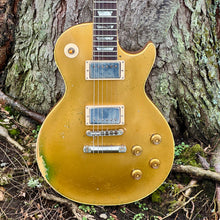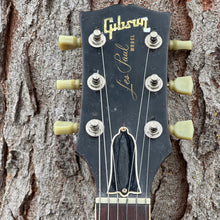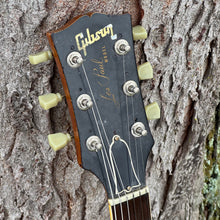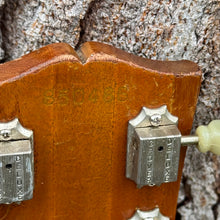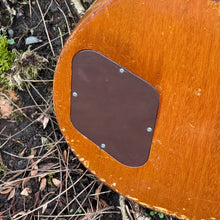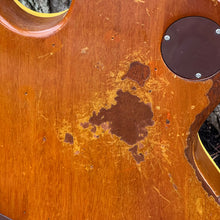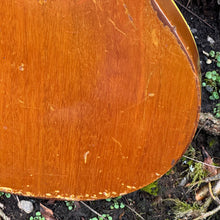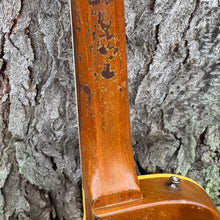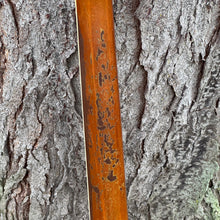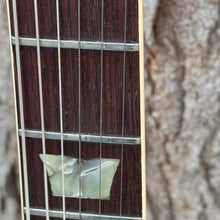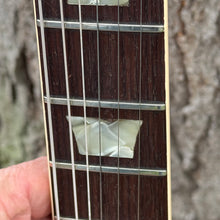
Here’s a killer Guitar for you! It’s a 1969 Les Paul Deluxe that has been “converted“ to 1957–1958 gold top cosmetics and full size humbucker pickups.
The pickups are mid-1960s pre-T-tops, which are about as close as you can get to a “real PAF” without the significantly higher price tag.
Sometimes vintage guitars are pretty clean, but have a few unfortunate cosmetic blemishes that keep them from being in the “mint” category. Collectors gaze at them and think of how they could be museum grade pieces if they just hadn’t been carelessly handled a few times. Of course, we all love the closet queen guitars that look like they belong in a museum.
Then there are guitars that have been worn in so much that they become as appealing as the extremely clean examples. The natural “relic” embodies the kind of look custom shops and individual builders work for years to learn to replicate. This is definitely one of those!
This guitar sounds killer and plays fabulously. It has lots of wear and Some scratches. But there are no cracks, brakes, or repairs to the body or neck.
While the conversion means this guitar is not “all original,” there are many that want a Les Paul Standard with connections to golden age of Gibson electrics (i.e. 1950s-1960s) but without having to sell their home to purchase one. Les Paul Standard “conversions” are becoming increasingly popular, and the late 60s Les Paul’s are great candidates as a starting point into this area of collecting.
The guitar still sports many of the crucial late 1960s features that set these off from their early 1970s counterparts (when a lot of changes were made). This one still has a one piece body (no pancake), no volute, no made in USA stamp, and the late 60s style Gibson Logo on the headstock. It has a three-piece neck characteristic of 1969. These also came stock with a 1 and 11/16th inch nut like they had in the 1950s and early 1960s—which is overwhelmingly preferred by most players. It has a 1960s harness installed, with visible date codes showing 1969 (some are covered in solder). It has the sprauge caps you see in that decade. The switch and switch wiring is new. The original switch was not working. It still has the plastic output jack plate (crazy since most of these broke).
The guitar comes with the original chrome patent number sticker bridge, the original tailpiece, and the original “deluxe” truss rod cover. But the guitar has been given VOS nickel hardware from a custom shop Les Paul to give it a 1950s look. The bridge posts and wheels are brass replacement. The white plastic pickup rings are also reproductions. A repro 1950s style “wide-bevel” truss rod cover is installed. Vintage strap buttons. The knobs are from the 1960s. The amber switch tip competes the look, but is also a repro.
As mentioned above the pickups are 1960s pre-T-tops. The patent number sticker T-top first appeared in 1965, but pre-T-tops can still be found in Gibson guitars for a few more years (especially those with gold hardware). It is not known what year or guitar these originally came from, but they have standard spaced pole pieces. The leads had been cut short so new leads were installed. On pickup had a dead coil, so one side had to be rewound. They both sound killer and are a great set for this instrument. The nickel covers are repro and have light aging on them.
Some other notes about the guitar. The back has some obvious wear to it. At one point the previous owner put something like a circular leather patch on the back to cover it. Just by looking at the finish you can’t tell that this was done. But there are some very small pin holes in the shape of a circle around the worn area that reveal that this was done. I have no idea why someone would do that—I quit trying to figure that kind of stuff out a long time ago. Some things you see on vintage guitars are just inexplicable! Thankfully, it doesn’t really stand out and since it is on the back it’s practically a non issue. Also, there are some small touched up spots around the tuner posts on the headstock. Again, not something you note at first, but something you notice once it is pointed out. I also have no idea why this was done.
The tuners are modern “Grover deluxe” tuners. The holes were reamed out wider than the stock holes to accommodate these tuners. They have a vintage look, but have the advantage of better tuning stability. The tuners were changed prior to my ownership.
All in all, it’s a guitar that has had some changes and obviously saw some play—but for good reason: it is a killer guitar!
The routing for the larger pickups was done a long time ago by the previous owner who had owned this guitar since the 1970s.its not a pro job but not the worst I’ve seen either. It was his main player and has the wear to prove it.
If you are looking to start a journey towards a vintage 1950s Les Paul and need a more affordable entry point, this is a great option. Or if you want a fabulous playing vintage Gibson with the look and feel of their “golden era” guitars, this may just be the one for you! I am not a fan of chopping up original examples to make these “conversions.” But thankfully the big changes were honestly done long ago when these were just tools for musicians to make music.
It comes in a more recent Gibson branded Les Paul hard case.













